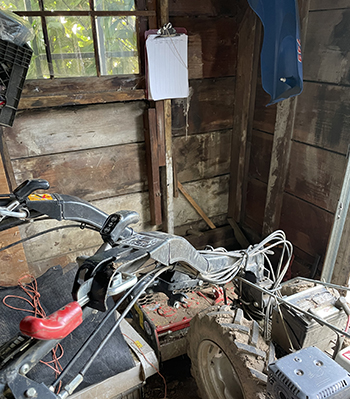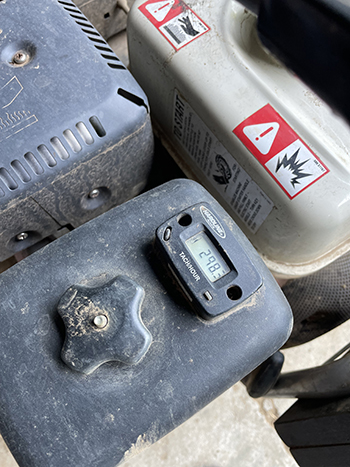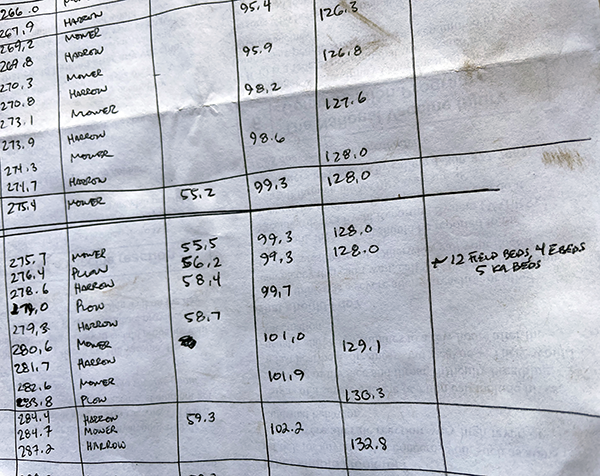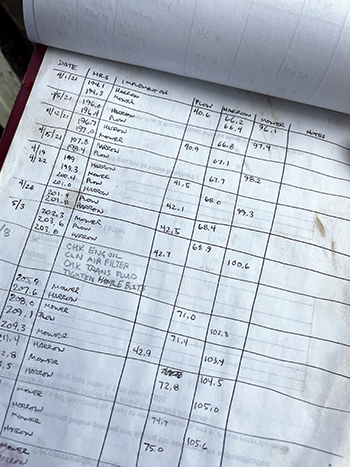How to keep track of what maintenance needs to be done when
I’ve been maintaining tractors and tractor implements on farms for more than a couple of decades now and I’m still using the same simple system I started with for keeping track of maintenance schedules for each piece of machinery. These days the tractor I use is a BCS with just two wheels, but the record keeping is still the same.

A clipboard with the hours and maintenance record hangs just above the BCS and Implements in our storage area. This is a visual reminder each time we change an implement to fill out the record of the hours.
Tractors, tractor implements and many other tools typically come with recommendations for regular maintenance based on the number of hours they’ve been used. For a tractor this is basically just like your car or truck which has recommended service intervals for things like oil changes and air filter cleanings every 5,000 miles, only on the tractor you’re tracking the hours of use, not the miles driven. If you want to know the regular maintenance needed and the recommended interval you just look those up in the owner’s manual. Keeping track of when you actually did the last maintenance, or when the next one is due is the trick.
Most tractors have a functional hour meter that keeps track of the total hours the machine has been used. One very simple way to keep track of when the next service is due is to use a piece of masking tape to make a sticker each time you do maintenance with the number of hours the meter should read next time it will need maintenance and put that near the hour meter on the dashboard where you can see it each time you start the tractor up.

A vibration activated hour meter is stuck to the air filter on our BCS motor and records the total hours used.
BCS tractors don’t come from the factory with an hour meter but many folks who sell them add a vibration activated hour meter. These are used for all sorts of machines in factories to track equipment maintenance intervals and they’re relatively inexpensive and very reliable. They literally stick onto the implement with industrial strength tape.
Most tractor implements don’t have an hour meter, but they still recommend greasing fittings, or changing gear oil after a specified number of hours of use. You could put a vibration activated hour meter onto every implement, but I’ve found it easier to just record the hours on the tractor when mounting an implement and then again when removing it. This will somewhat overestimate the hours on the implement since some of the time is spent driving around without actually running the implement, but better to do the maintenance more often than not enough.

I leave space in the right column for notes. In this case I’ve made a note of how many beds were plowed while the implement was on. Having this information gave me the information to calculate a rate (minutes/bed) which helps me with planning and cost analysis.
For our BCS, to make recording these hours as simple as possible I have a clipboard that hangs right above the spot where we store the implements and every time I change an implement I write the hours on the meter on a sheet of paper and then add the amount of time since the last change to the total for the implement that just came off.
On that same sheet I record any maintenance that happens so that it’s easy to look back at when the last maintenance was and how many hours have elapsed since. In the old days when I was taking care of more tractors and implements, I had separate clip boards for each implement. At the top of each record sheet for each implement I had a list of the regular maintenance intervals to make it easier to remember what needed to happen and when. I created these sheets using Excel to give a nice grid to fill in. Now that I’m only making one chart for the BCS implements I just hand draw lines for the columns on a sheet of paper and keep track of when maintenance needs to happen in my head (and subsequently don’t do it often enough!)

On our current maintenance sheet we record the date, hours on the meter, what implement is being put on, and the total number of hours on each implement. There is also a column for notes. Here you can see that maintenance checks on the BCS were performed on 5/8 at 203.8 hours. Keeping the record doesn’t mean the task gets done, just that we know when it should be done.
Keeping good records doesn’t automatically mean that the maintenance will get done, but if you’re using them correctly they should let you rest easy between maintenance intervals and then remind you when the maintenance actually needs to be done and when it’s badly overdue!
An additional benefit to the records is that they can also be used for future planning and cost analysis. Using the notes column you can record what the implement was used for, for example how many beds were harrowed in the time the implement was on. This can give you a decent estimate of the amount of time (and thus expense) it takes to harrow a bed.
Josh Volk farms in Portland, Oregon, and does consulting and education under the name Slow Hand Farm. He is the author of the books Compact Farms: 15 Proven Plans for Market Farms on 5 Acres or Less, and Build Your Own Farm Tools, Equipment & Systems for the Small-Scale Farm & Market Garden, both available from Growing for Market. He can be found at SlowHandFarm.com.

